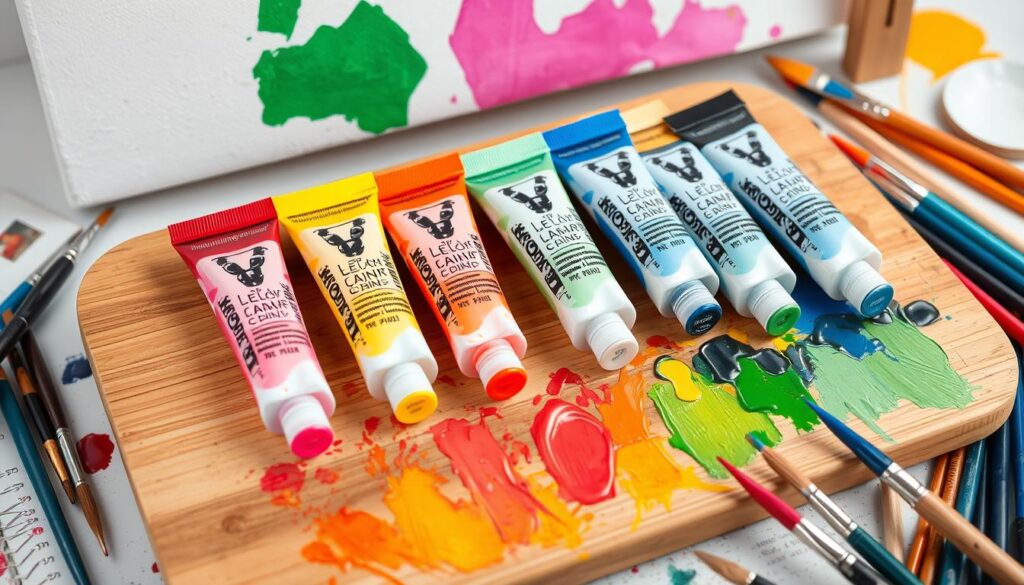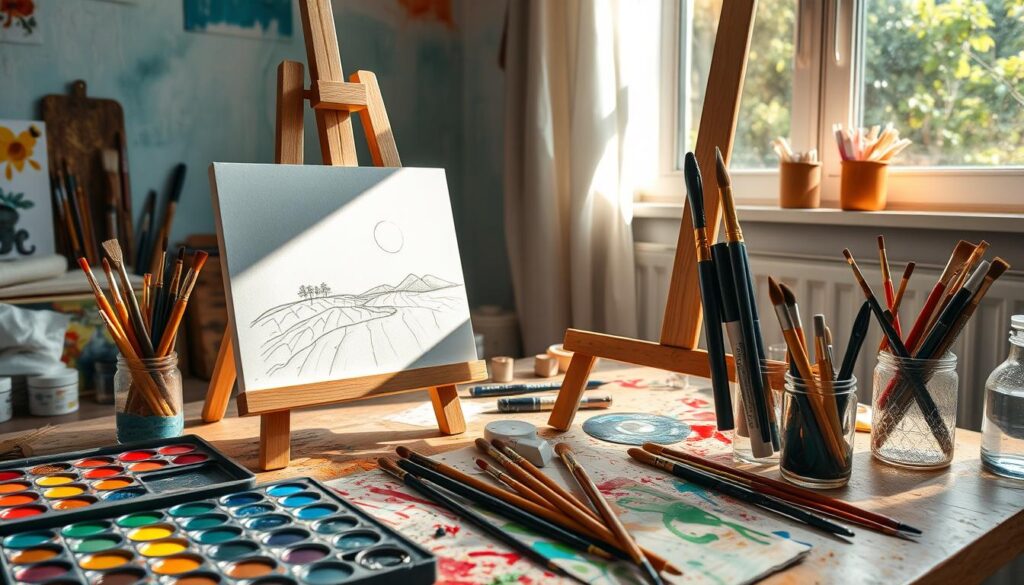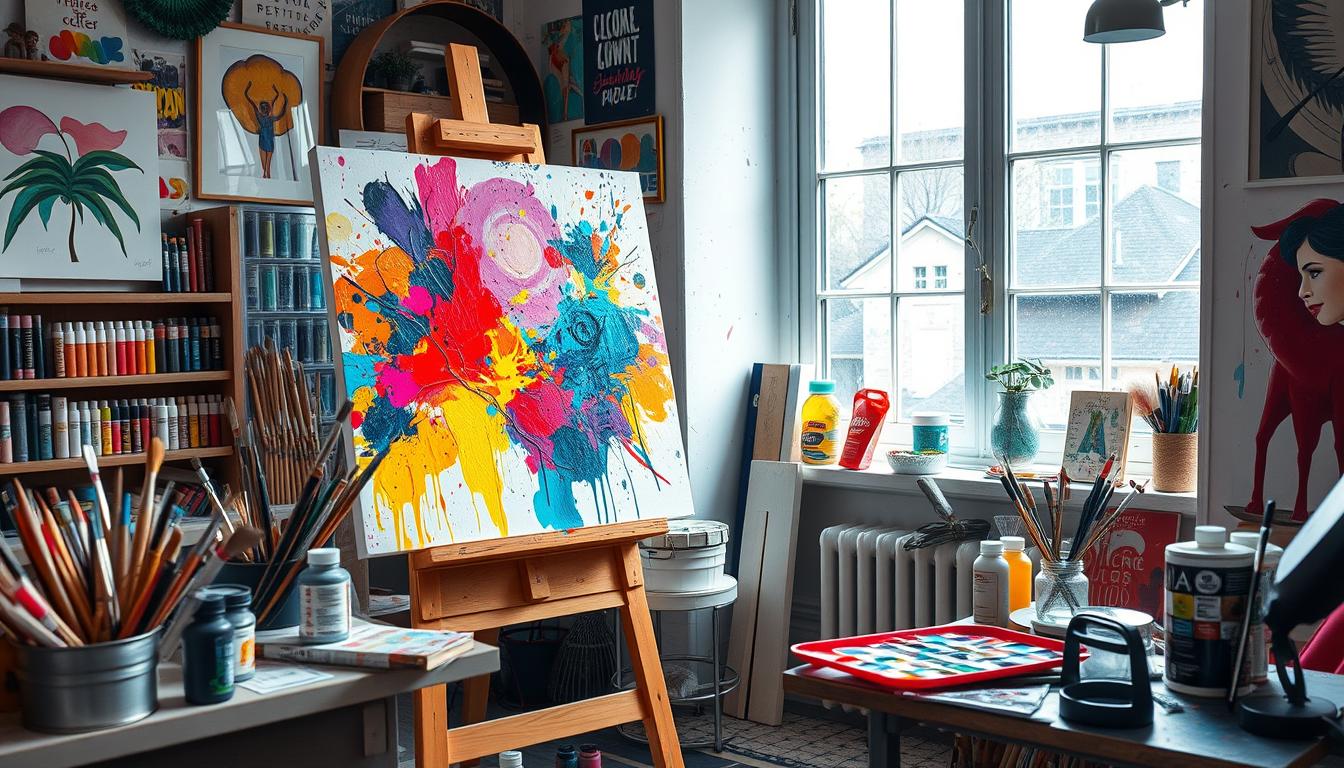This post contains affiliate links.
Do you recall the joy of drawing with crayons as a child? Back then, we didn’t worry about making a mess or what others thought. As adults, we often think art is only for the naturally talented. This belief makes many shy away from trying. But what if I said learning to paint with acrylics is easier than you think?
Acrylic painting is perfect for beginners. It’s easy to start and offers endless possibilities. This beginner’s guide to acrylic painting will make things simple. It helps you find your inner artist with ease and happiness. If you want to explore your creativity or rediscover a lost passion, this guide has all the basics and tips you need to begin your artistic journey.
Acrylics dry fast and are versatile. You can create thin washes or thick, textured strokes. Cleanup is easy, too. Yet, many new artists don’t start because they feel overwhelmed. They have the paints but lack direction. We aim to change that. Our guide provides step-by-step instructions, encouraging practice and effort.
Let’s get started. Say goodbye to hesitation and let your creativity soar. This acrylic painting for absolute beginners guide is your first step to becoming an artist.
Key Takeaways:
- Acrylic painting is beginner-friendly due to its quick-drying nature and easy clean-up with water.
- This guide covers essential materials, techniques, and workspace setup to help you start confidently.
- Mixing and understanding colors is a fundamental skill that enhances the painting experience.
- Embrace a growth mindset: Improvement comes with practice and guidance, not just inherent talent.
- Overcome procrastination by learning structured, step-by-step techniques and creating a dedicated painting space.
Introduction to Acrylic Painting
Acrylic painting is known for being versatile and easy to use. It’s great for beginners in art. Since the 1940s, acrylic paints have gained popularity. They dry quickly and are easy to clean because they’re water-based.
Learning acrylic painting basics for newcomers is key. Acrylics stick to many surfaces like canvas and wood. This makes them perfect for trying new artistic techniques. You can use them in many ways, including dry brushing and glazing.
Acrylics dry fast, which many beginners love. This lets artists add new layers without a long wait. Also, student quality paints are more budget-friendly. They use less expensive materials but still work well. Check out this beginner acrylic painting techniques guide for more.
Exploring different techniques is encouraged for new artists. There are many easy techniques available. This means anyone can start creating with acrylics. To really learn, follow a detailed guide like this one on acrylic painting projects.
Acrylic paint offers endless art possibilities. It makes setting up your art space and trying different methods enjoyable. Acrylic painting is a fun and rewarding hobby for all.
Essential Beginner-Friendly Acrylic Painting Supplies
Starting your acrylic painting journey means getting the right supplies. You need acrylic paints, brushes, and a painting surface. These are the basics for any beginner.
Paints
Acrylic paints dry quickly and are great for both beginners and pros. If you’re new to painting, start with student quality paints. Brands like Golden, Liquitex, and Winsor & Newton have paints perfect for starters. You might want to get a 10-color set, but even 6 colors can be enough. Mixing your colors can help save money.
Brushes
For different painting techniques, you’ll need various brushes. Start with three different sizes: large, medium, and small. These sizes will meet most of your painting needs. Stores like Michael’s, Blick Art Materials, and Hobby Lobby offer brushes that are good for beginners.
Surfaces and Canvases
The right painting surface is key for your art. There are many options like canvas, canvas boards, and wood panels. For adults, sizes like 16 x 20, 12 x 16, and 11 x 14 are recommended. Kids might prefer sizes like 11 x 14, 9 x 12, and 8 x 10. These surfaces work well with acrylic paint, making your artwork vibrant and durable.
| Popular Surfaces | Recommended Sizes for Adults | Recommended Sizes for Kids |
|---|---|---|
| Gallery Wrapped Canvas | 16 x 20 | 11 x 14 |
| Canvas Board | 12 x 16 | 9 x 12 |
| Canvas Paper | 11 x 14 | 8 x 10 |
With these beginner-friendly supplies, you’re ready to make great art. Starting with quality beginner paints will make learning better. It helps you create art that looks professional.
Types of Acrylic Paints: Choosing the Best for Beginners
Jumping into acrylic painting starts with knowing the available paint types. It’s important for beginners to pick paints wisely, focusing on quality, thickness, and cost.
Student Quality vs. Artist Quality Acrylics
Student and artist quality acrylics differ mainly in pigment and binder. For example, student paints like Plaid FolkArt are cheaper and bright but less vibrant, ideal for those just starting out. Artist quality paints, like Liquitex Basics, offer deeper colors because they contain more pigment. This means you get better coverage and need fewer layers.

Heavy Body vs. Soft Body Acrylics
It’s crucial to know paint consistency when looking for beginner paints. Heavy body paints, such as Golden Heavy Body, are thick and show brush strokes, great for texture. Soft body paints, like Liquitex Soft Body, are smoother and better for detailed or flowing work. The choice depends on what texture and finish you want in your art.
High Flow Acrylics and Acrylic Inks
If you like marbling, staining, or using an airbrush, consider high flow acrylics and inks. These have a watery consistency, perfect for thin washes and bright colors. Golden High Flow Acrylics let you experiment with diverse artistic styles. Acrylic inks, like those from Liquitex or Winsor & Newton, combine ink’s fluidity with acrylic’s lasting effect.
Choosing the right acrylic paints as a beginner means understanding your style and how much you want to spend. Starting with student grade paints and moving to artist grade as you improve is a smart way to develop your painting skills confidently.
Setting Up Your Painting Workspace
Getting your acrylic painting setup right is vital for beginners in acrylics. It should be tidy, comfortable, and full of everything needed for inspiration and focus.
First, pick a spot for your painting area. It should have lots of natural light for true color vision. If you can’t get natural light, get good daylight bulbs. They make a big difference in how you see colors.
Make sure to have a sturdy easel. It keeps your canvas stable and lets you paint from various angles. This can really help improve how you paint. Also, find a comfy chair or stool, as you might paint for hours.
Your setup needs a place to store supplies neatly. Use drawers, shelves, or bins for your paints, brushes, palettes, and more. This organization saves time and keeps clutter from blocking your creativity.
Also, have a table or area for mixing paints. You’ll need a palette for blending colors. And don’t forget a jar of water and paper towels for quick brush cleaning. Try using different surfaces like wood, glass, or paper to see what works best for you.
Keep your brushes clean, work in layers, and your paints moist. These steps are key to a smooth painting experience. Being consistent in how you manage your workspace boosts your creative output and the joy of painting.
Acrylic Painting Basics for Newcomers
For newcomers, mastering acrylic painting basics opens up a world of art. Learning about paint consistency and viscosity is crucial. It helps you get the effects you want. Mixing colors is also vital. Using a color wheel and practicing on a palette can make your work more vibrant. Priming canvases with gesso makes the surface better for painting. It gives the paint something to stick to. If you add color to the primer, the painting will look more lively.
Understanding Consistency and Viscosity
Understanding paint’s consistency and viscosity is key for beginners. Adding more water to paint gives it a matte finish, similar to watercolor. But, using paint thickly can add texture and depth to your work. Heavy body acrylics are great for this. They are thick and keep the shape of your brush strokes.

Mixing Colors
Mixing colors well can take your art to the next level. Beginners should try making a color chart with primary colors, plus white and black. This helps you remember how to mix hues. Using shades of the same color can make your paintings pop. Brands like Liquitex and Golden have really vibrant colors because of their high pigment concentration.
Priming Your Canvas
Priming your canvas is a must-do for beginners. A coat of gesso readies the canvas and improves paint stickiness. You can tint your primer with colors for an interesting start. This adds depth and vibrancy to your artwork. It makes sure your paint goes on smooth and even.
| Technique | Description |
|---|---|
| Water Usage | Adding water creates a matte watercolor-like finish. |
| Dabbing | Using stiff bristles or paper towels for unique textures. |
| Stippling | Repetitive dabbing to create solid shapes and interesting textures. |
| Acrylic Pouring | Pouring paint creates various effects like swirls and marble finishes. |
| Lifting Paint | Removing sections to create soft backgrounds and textures. |
| Dry Brushing | Adding distinctive shapes and layers with a dry brush. |
Beginner Acrylic Painting Techniques
There are key beginner acrylic painting techniques you should know. They are dry brushing, wet on wet technique, and stippling or pointillism. Each one brings unique textures and makes your art pop. Learning these techniques is crucial for getting good at acrylic painting.
Dry Brushing
Dry brushing adds texture and fine details to your art. A dry brush with a bit of paint is lightly swept across the canvas. This creates subtle layers. It’s great for painting nature like rocks, leaves, or fur. Check out beginner acrylic painting tutorials for more on dry brushing.
Wet on Wet Technique
Wet on wet technique means putting wet paint on a wet surface. This lets colors blend smoothly. It’s good for making smooth transitions and dynamic scenes. Beginners find their paintings look more lively with this method. It works well for peaceful or active scenes, adding realism and depth.
Stippling and Pointillism
Stippling and pointillism use tiny dots to make images. These dots create realism or an impressionistic feel. Change the dot size and how close they are to get different textures and patterns. A personal color mix chart can help remember color blends while painting.
If you’re starting out, explore different painting methods. Many resources, like tutorials and workshops, can help improve your painting skills. These beginner techniques are a great place to start.
- Dry brushing for textured effects and highlights.
- Wet on wet technique for seamless color blending.
- Stippling and pointillism for detailed and impressionistic effects.
| Technique | Advantages | Difficulty Level |
|---|---|---|
| Dry Brushing | Creates textured effects and highlights | Easy to Moderate |
| Wet on Wet | Blends colors seamlessly | Moderate to Advanced |
| Stippling/Pointillism | Produces detailed textures | Moderate to Advanced |
Step-by-Step Acrylic Painting Tutorial for Beginners
Starting your art journey with acrylics is exciting. This guide offers a clear path for beginners. With step-by-step instructions, even newcomers will find it easy.
“Art enables us to find ourselves and lose ourselves at the same time.” – Thomas Merton
This acrylic painting how-to will teach you the essentials. You’ll learn everything from sketching your idea to adding final touches. Let’s dive into the steps:
- Sketch Your Layout: Start with a basic sketch on your canvas. This step is the foundation for your painting.
- Block in Base Colors: Add broad color areas to set your painting’s primary tones.
- Build Up Layers: Add paint layers gradually, allowing drying time between each. This brings depth to your art.
- Detailing: For detailed sections, use finer brushes. Focus on the details that add life to your painting.
- Final Touches: Review and add any final details or adjustments to finish your art.
For a better learning experience, explore these varied tutorials:
| Type of Tutorial | Percentage |
|---|---|
| Flower Painting | 25% |
| Blending Techniques | 15% |
| Tree-Related Paintings | 10% |
| Landscape Elements | 5% |
| Abstract Techniques | 5% |
| Palette Knife Techniques | 5% |
| Poured Acrylic Techniques | 5% |
These tutorials are perfect for visual learners. They include videos that show the painting process from start to finish. Whether you’re into flowers, landscapes, or abstracts, there’s a video for you.
Jump into this journey and have fun creating your acrylic masterpiece!
Fun and Easy Acrylic Painting Ideas
Getting inspired is crucial when starting acrylic painting. This section shares many cool painting ideas for beginners. It keeps the learning fun and interesting. You can try painting beautiful landscapes, vivid abstract pieces, or adorable animal portraits. These ideas are perfect for all tastes and skills.
Simple Landscapes
For beginners, creating simple landscapes is a great start. It teaches about horizon lines and the look of distance. These painting projects help you practice mixing colors and creating depth. You might start with a sunset or a quiet forest path, as the Guywann guide suggests. This guide gives easy steps and advice on using different paints. So, beginners can feel sure of their work.
Abstract Art
Abstract art lets beginners use their imagination freely. It’s great for those who don’t want to stick to strict shapes. This style can focus on big subjects or simple shapes. It’s a chance to play with textures and colors. The guide suggests starting with a few colors like white, yellow, and grey to keep it simple. Helpful videos and quality paint kits make these projects fun and easy.
Animal Portraits
Painting animal portraits is fun but challenging for beginners. It’s all about capturing the animal’s spirit. You start with simple shapes, then add layers to create depth. Good brush skills and attention to detail are important. Using special brushes helps in painting fur and feathers accurately. For newcomers, painting kits with guides are a great help in learning these skills.
These simple and fun painting ideas aim to spark your creativity and help you learn. They make building basic skills enjoyable and supportive. For more ideas and to begin your painting adventure, check out the guide at Guywann.
FAQ
What makes acrylic painting ideal for absolute beginners?
What are the essential beginner-friendly acrylic painting supplies?
How do I choose the best acrylic paints for beginners?
What is the difference between heavy body and soft body acrylics?
What should I include in my painting workspace setup?
Why is understanding paint consistency and viscosity crucial for beginners?
How important is color mixing in acrylic painting?
How do I prime a canvas for acrylic painting?
Can you explain some basic acrylic painting techniques for beginners?
Can I follow a step-by-step acrylic painting tutorial to improve my skills?
What are some easy acrylic painting ideas for beginners?
This post contains affiliate links.

